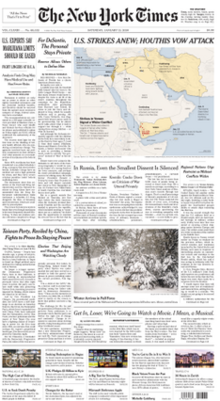Facts About News Articles Uncovered
Table of Contents3 Simple Techniques For News ArticlesAll About News ArticlesSome Known Facts About News Articles.The 30-Second Trick For News ArticlesNews Articles Things To Know Before You Get This
Great expertise of different subjects offers students a competitive side over their peers. Also though digital and social media sites are conveniently easily accessible, we ought to not neglect exactly how vital it is to check out the papers. Moms and dads have to attempt and instill the routine of checking out a paper as a day-to-day routine to proceed the heritage of the revered print medium.Information stories also have a minimum of one of the adhering to crucial features about the designated target market: proximity, prestige, timeliness, human interest, quirk, or effect. The related term journalese is often made use of, usually pejoratively, to describe news-style writing. Another is headlinese. Papers typically abide by an expository writing design.
Within these limits, newspaper article also aim to be detailed. Nevertheless, various other aspects are entailed, some stylistic and some stemmed from the media form. Among the bigger and much more recognized newspapers, justness and equilibrium is a significant aspect in providing details. Commentary is normally restricted to a separate area, though each paper might have a different total slant.
Papers with an international target market, for example, have a tendency to utilize a more formal design of writing. News Articles.; usual design guides include the and the United States News Design Publication.
The Basic Principles Of News Articles
As a regulation, journalists will not utilize a lengthy word when a short one will certainly do. They utilize subject-verb-object construction and dazzling, energetic prose (see Grammar). They use anecdotes, instances and allegories, and they hardly ever depend upon generalizations or abstract ideas. News writers attempt to stay clear of making use of the very same word greater than as soon as in a paragraph (in some cases called an "resemble" or "word mirror").
However, headlines sometimes omit the topic (e.g., "Jumps From Boat, Catches in Wheel") or verb (e.g., "Feline lady lucky"). A subhead (likewise subhed, sub-headline, subheading, caption, deck or dek) can be either a subservient title under the primary heading, or the heading of a subsection of the post. It is a heading that precedes the primary message, or a team of paragraphs of the major message.

Added signboards of any of these kinds might show up later on in the short article (especially on succeeding pages) to lure further analysis. Such billboards are also utilized as tips to the article in various other sections of the magazine or website, or as ads for the piece in other magazine or sites. Regular structure with title, lead paragraph (recap in strong), various other paragraphs (details) and call information.

Example of a hard-lead paragraph NASA is proposing an additional room task. The firm's budget plan request, introduced today, consisted of a strategy to send out another mission to the Moon. This time the firm intends to establish a long-term facility as a jumping-off factor for other area experiences. The spending plan requests around $10 billion for the job.
An "off-lead" is the second most important front web page news of the day. To "hide the lead" is to begin the write-up with background details or details of second significance to the readers, requiring them to read more deeply right into a short article than they should have to in order to find the essential factors.
Some Known Incorrect Statements About News Articles
Usual usage is that a person or 2 sentences each form their very own paragraph. Reporters typically explain the company or framework of a newspaper article as an upside down pyramid. The essential and most interesting aspects of a tale are placed at the start, with sustaining details following in order of decreasing value.
It permits individuals to discover a topic to only the depth that their curiosity takes them, and without the imposition of information or subtleties that they might take into consideration unnecessary, but still making that information available to much more interested readers. The inverted pyramid structure also enables short articles to be trimmed to any arbitrary length during format, to suit the room readily available.
Some writers start their tales with the "1-2-3 lead", yet there are many sort of lead YOURURL.com readily available. This layout usually begins with a "Five Ws" opening paragraph (as described above), adhered to by an indirect quote that offers to sustain a major element of the first paragraph, and after that a straight quote to sustain the indirect quote. [] A kicker can refer to multiple things: The last story current broadcast; a "pleased" story to finish the program.
Longer articles, such as publication cover short articles and the pieces that lead the inside sections of a paper, are referred to as. Feature tales differ from straight information in numerous ways. Foremost is the absence of a straight-news lead, many of the time. Instead of providing the essence of a tale in advance, function writers might try to tempt viewers in.
How News Articles can Save You Time, Stress, and Money.
The journalist often information interactions with meeting topics, making the item extra individual. A function's very first paragraphs frequently relate an appealing minute or event, as in an "unscientific lead". From the particulars of a person or episode, go to this site its sight swiftly expands to generalities concerning the story's topic. The area that signifies what an attribute has to do with is called the or billboard.

The Editor's Tool kit: A Referral Guide for Beginners and Professionals (2001) Allan M. Siegal and William G. Connolly. The New York City Times Guidebook of Style and Usage: The Authorities Design Guide Used by the Writers and Editors of the Globe's Most Authoritative Paper (2002) M. L. Stein, Susan Paterno, and R.